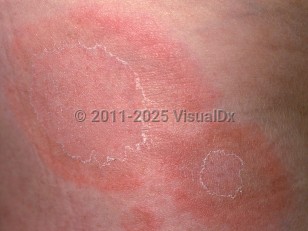Erythema annulare centrifugum in Child
Synopsis

EAC can occur at any age but tends to affect young or middle-aged adults. There is no sex or racial predilection. Most cases of pediatric EAC are idiopathic, typically self-limited, and spontaneous resolution is common. However, new lesions may continue to erupt while old lesions resolve. EAC may be asymptomatic or may be accompanied by pruritus.
Cutaneous fungal infection and Helicobacter pylori infection are the most common concomitant infectious diseases. However, other infectious culprits, including ingestion of Penicillium in blue cheese and parasitic, bacterial (eg, Escherichia coli, Pseudomonas, latent tuberculosis), and viral (eg, Epstein-Barr virus, SARS-CoV-2) associations have been identified. Annual or seasonal reoccurrence of EAC has been reported, although specific triggers in these cases remain unknown.
Certain drugs have been reported to cause EAC-like lesions, including piroxicam, penicillins, chloroquine and hydroxychloroquine, hydrochlorothiazide, spironolactone, cimetidine, phenolphthalein, amitriptyline, hydrochlorothiazide, salicylates, ustekinumab, rituximab, pegylated interferon alpha / ribavirin combination therapy, azacitidine, and antithymocyte globulin.
Single cases of EAC in children with celiac disease, familial cholinergic urticaria, and cold urticaria have been reported. Numerous other systemic diseases have been reported in adult EAC; however, this has not been mirrored in the pediatric population.
EAC in the setting of an underlying malignancy has been infrequently described in children with lymphoproliferative malignancies (ie, acute lymphoid leukemia, acute myeloid leukemia). Malignancy-associated EAC is termed paraneoplastic EAC eruption (PEACE).
Codes
L53.1 – Erythema annulare centrifugum
SNOMEDCT:
399914006 – Erythema annulare centrifugum
Look For
Subscription Required
Diagnostic Pearls
Subscription Required
Differential Diagnosis & Pitfalls

Subscription Required
Best Tests
Subscription Required
Management Pearls
Subscription Required
Therapy
Subscription Required
Drug Reaction Data
Subscription Required
References
Subscription Required
Last Updated:07/24/2025

